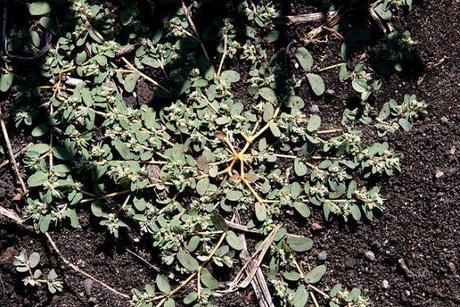I listen to Margaret Roach‘s excellent podcast, A Way to Garden, and read her website of the same name. This year Margaret has been seeking to identify the weeds in her garden, to better understand their life cycles and ultimately get the upper hand on them.
This is wise advice, and I am hoping to (gradually) acquire this knowledge of the plants in my own garden with which I wage perpetual battle. Today I am starting with an easy one: spotted spurge, known also as Euphorbia maculata or Chamaesyce maculata.

Although it grows from a taproot, I have always found spotted spurge fairly easy to pull up with a hand rake. But maybe this is my problem: Perhaps my technique yields the topgrowth, but part of the taproot remains, leaving a source from which it can regrow. Or my problem could be that I have a lot of it and don’t get around to eradicating it, so it multiplies.
This is a summer annual weed, which means that if I can get to it early (and get that taproot!), before it sets seed, I should be able to get it under control. It emerges in mid-summer, and can flower within 3 to 4 weeks according to NC Turffiles, so that time before flowering is the critical window in which I need to act. I fear the ship may have sailed, but I may still be able to row after it. Summer lasts a long time where I live.
Also, like many Euphorbias, its stems contain a sap that can be irritating to sensitive skin. Must remember to get out the gloves.
If you have spotted spurge in your lawn, you can help control it by raising the cutting height of your lawn mower. Higher-standing grass cuts down on the amount of light reaching the weed seeds in the soil. As it happens, I don’t have a lawn to mow. But I do have plenty of spots that could use a good top-up with mulch, which is also an effective control.

